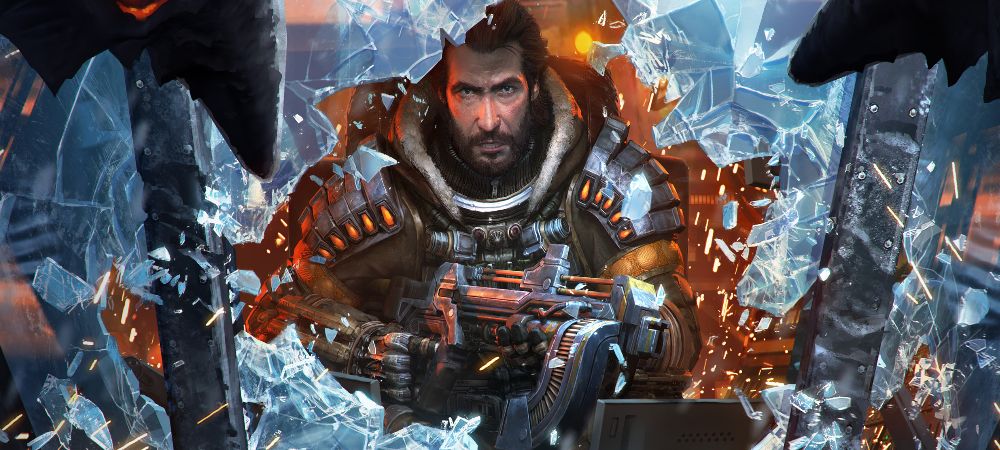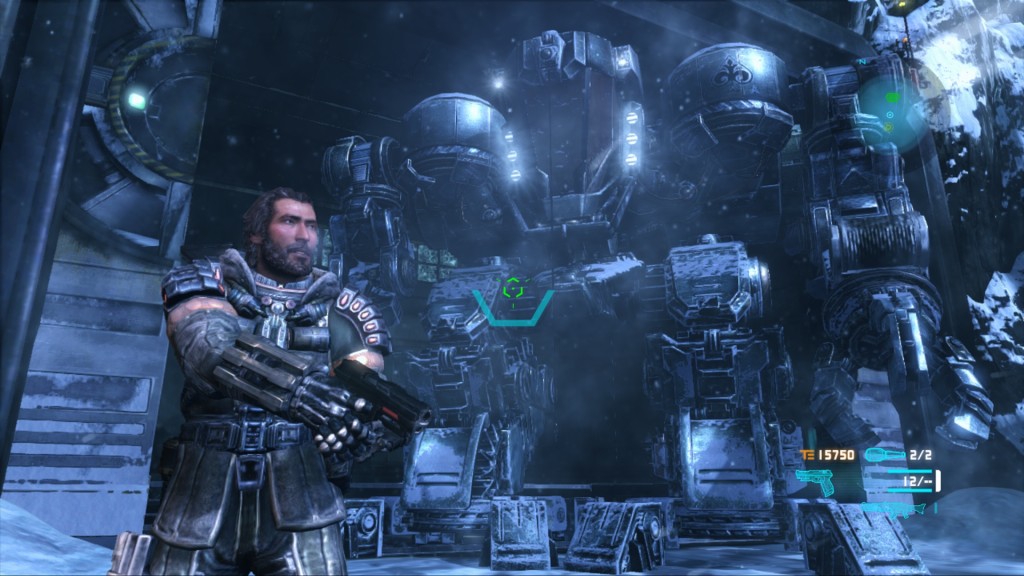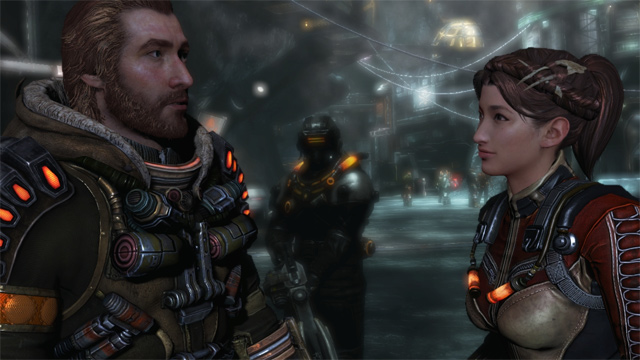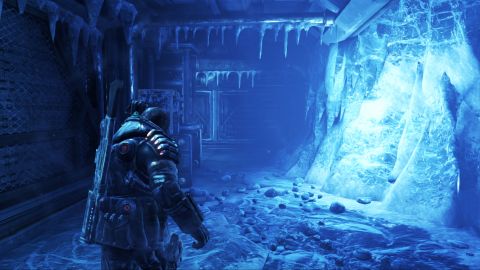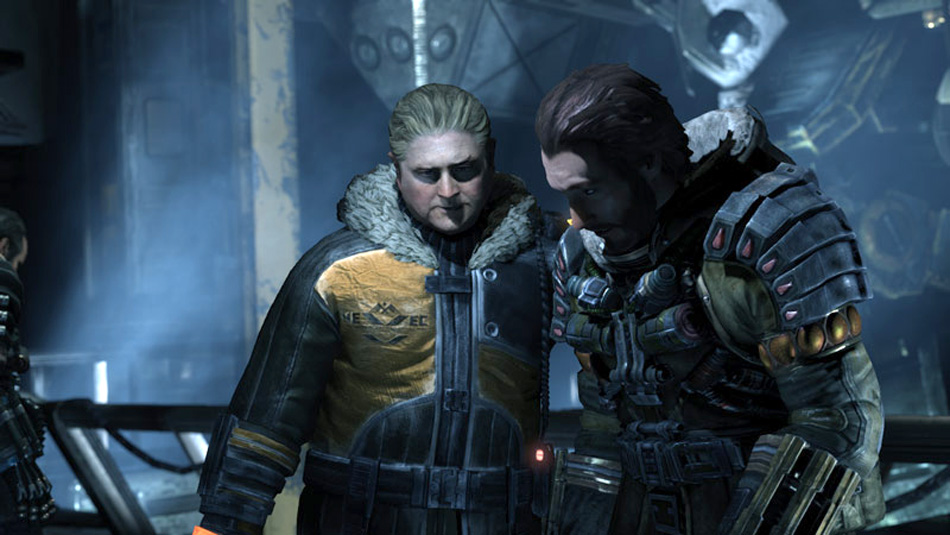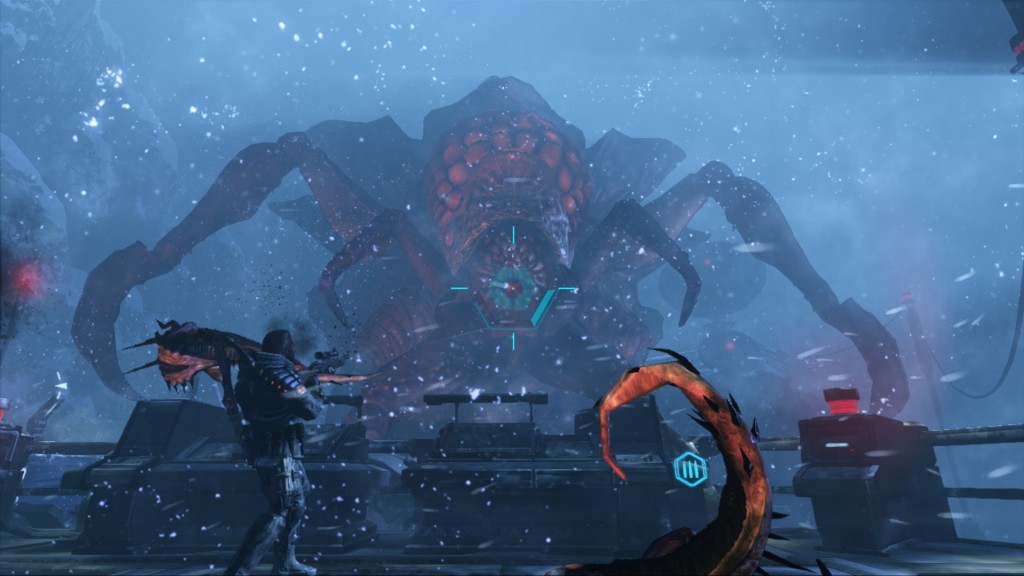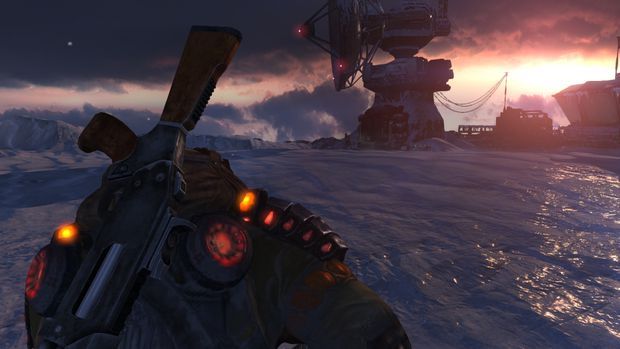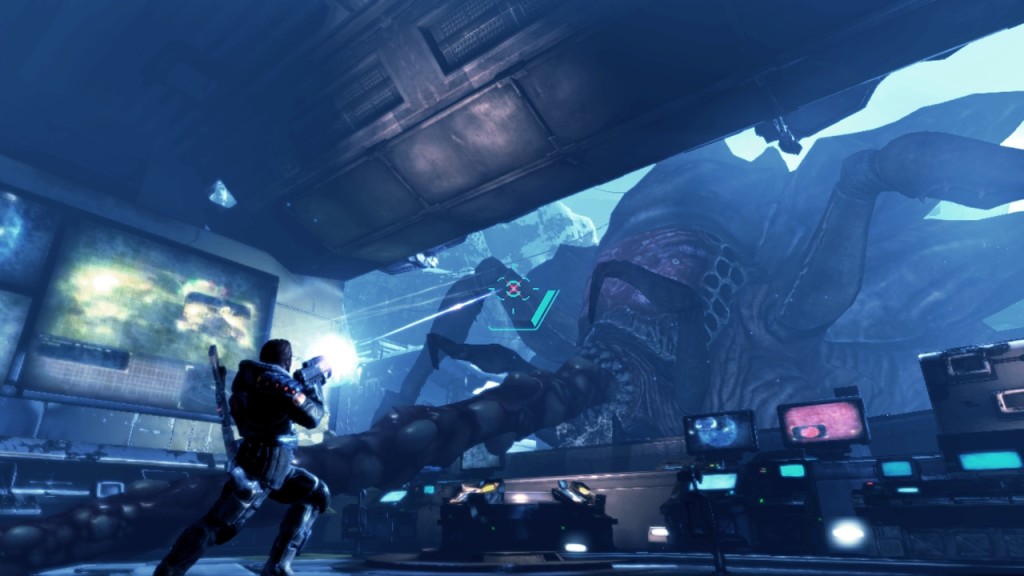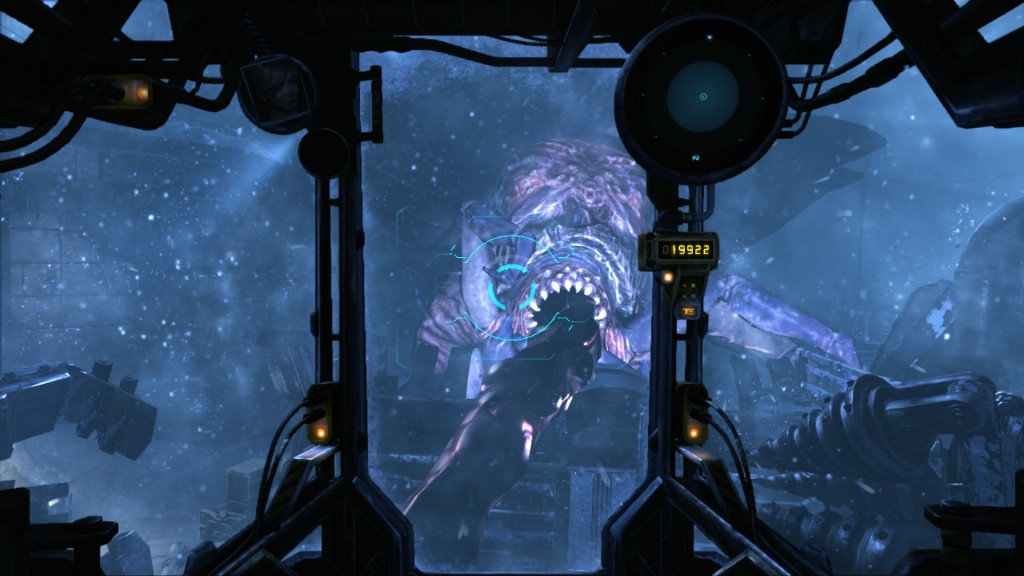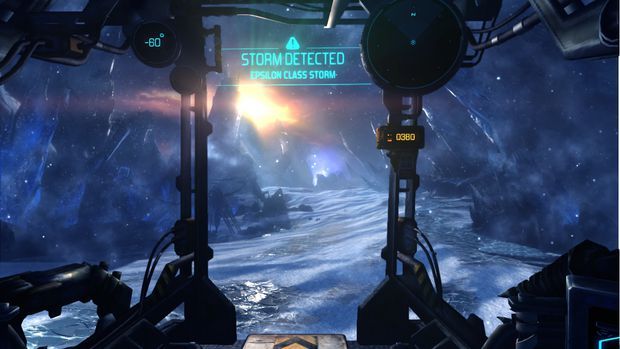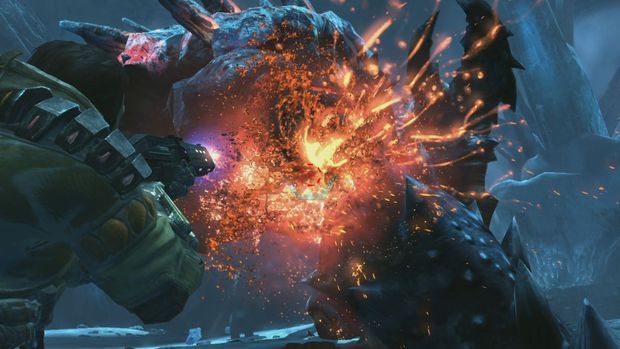Once again, we find ourselves on E.D.N. II, an unforgiving ball of ice and snow in the far reaches of space. An energy crisis on Earth is threatening the future of humanity, but not-at-all-sinister mega-corporation NEVEC – who have a lot in common with the Alien universe’s omnipresent Weyland-Yutani, even down to their logo – has found a way to solve it: a magical substance called thermal energy.
In the third iteration of the Lost Planet series, some things are gained, and some are, appropriately enough, lost. Lost Planet 2 was a frustrating and beautiful concoction, loaded with grand ideas that all too often sacrificed basic playability. In this mediocre prequel to the original Lost Planet, the frustrations are minimal, but so are the ideas; its predecessor’s variety and visual panache are steamrolled in favor of perfectly decent, perfectly standard shooting encounters. Lost Planet 3 is a difficult game to hate and an equally difficult game to adore. It might feature monstrous aliens, but it never thinks big.
One aspect of this third-person shooter that will keep you thinking, however, is its story, a surprise given the series’ lack of a personal touch and grand plot ambitions. The early hours move slowly, introducing you to hero Jim Peyton, who has journeyed across the blackness of space to the planet E.D.N. III to assist the Neo-Venus Construction company in its mining efforts. Jim is an excellent everyman, frequently exchanging personal video messages with his devoted wife, who is raising their newborn son while Jim works toward a brighter financial future. The couple labor to maintain a tone of normalcy, but never fully contain their misgivings and personal longing. The dialogue is natural and delivered gracefully; Jim’s love is not characterized by overwhelming passion, but by quiet adoration and sincere concern.
This glowing orange gunk may be the key to saving our species, but there’s a catch. The stuff is fiercely guarded by E.D.N.’s natives, the Akrid. So while NEVEC have managed to get a foothold on the planet, their colonies are constantly besieged by these terrifying insect-beasts. That’s where you come in. You are Jim Peyton, a Nicolas Cage look-alike who’s been hired by NEVEC as a sort of sci-fi handyman. Early missions see you rescuing lost colonists, fixing things around the base with your mech, and, naturally, killing lots of Akrid.
While performing odd jobs and fighting off the wildlife that threatens the mining operation, Jim spots a figure eying him in the distance. Jim’s paranoia turns to confusion as he uncovers truths about NEVEC and the indiscretions of the company’s past. Here, the tale begins to follow recognizable paths, invoking elements of stories like Pocahontas and James Cameron’s Avatar by contrasting the greed of the invader with the purity of the land. But it’s how Lost Planet 3 subverts cliches that make it so compelling. In fiction, lines like “I didn’t know you had a wife” often lead to predictable story outcomes–but not here. Lost Planet 3 avoids overt moralizing and soap-opera melodrama, instead placing ordinary people in extraordinary circumstances and allowing them to find their way.
That isn’t to say there aren’t sour notes. A miner with a deplorable French accent tops that list, though an annoyingly chatty engineer can also grate on your nerves. Both ultimately earn a vital place in the story, though not before injuring your sense of good taste with their cliched characterizations. The game’s tone wanders, sometimes shooting for “space cowboy” a la StarCraft or Firefly, and other times getting jokey, going so far as to point out its own mechanical shortcomings. A little lighthearted humor is appreciated, but when it’s a bit of dialogue pointing out how often you have to turn on an elevator’s power, you can’t help but wish developer Spark Unlimited had avoided repetitive mission design rather than cracked wise about it.
One of the most surprising things about Lost Planet 3 is how entertaining the story and characters are. While a lot of ‘Westernised’ Japanese games are unceremoniously stripped of their personality, this is full of the stuff. Peyton is a charming lead, and video messages from his wife, which play in his mech’s cockpit as he moves around the base, paint a picture of a good-nature family man working to provide for his family back on Earth. He’s a welcome change from the usual one liner-spouting action lunk, and he has a magnificent beard to boot.
That repetition is a problem. Many of Lost Planet 3’s missions have you heading out into E.D.N. III’s icy wilderness to perform odd jobs for NEVEC or other allies, flipping switches, riding elevators, and shooting some aliens in a comfortable but overfamiliar pattern. Like in the previous games, your primary foes are the akrid, aliens primarily known for their insectlike appearance and the glowing orange growths that indicate weak points. Previously, fighting the largest of these creatures could be both a stunning and frustrating affair, with their outlandish attacks sending you flying through the air and into drifts of snow, where you had to struggle to your feet and resume battle. Combat arenas were often large and gave you the opportunity to pilot combat mechs, and giant akrid forced you to use your wits wIn Lost Planet 3, the distress and the diversity have both been toned down. You face some large akrid, but you do so without worry of being bowled over by numerous enemies and paralyzed by endless animation loops. Yet with greater playability also comes greater predictability. Regardless of the monster you face, the tactic remains the same: you tumble out of the way, the creature gets stuck for a moment, and you shoot at the glowing bits. And when you aren’t fighting the bigger akrid, you’re fighting off the smaller ones, which you can typically dispose of with a few shotgun blasts. And you do all of this in samey gray-white corridors and in small arenas frigid with wind and snow.
The action is bog-standard shooting, and the encounters are tame when compared to previous Lost Planet games. New this round is a cover system, though you rarely need to use it in the single-player campaign, and it’s bizarre to see non-humanoid life-forms sticking against cover and rising up to fling projectiles at you. Yet there’s still joy in watching orange thermal energy burst from an akrid’s vulnerable wounds when you shoot it, not to mention the sense of relief that comes from smashing its iced corpse to smithereens. In the first case, you see the lifeblood leaking from your foe; in the second, you prove your superiority by vanquishing all remnants of it. The combination makes for a rewarding power trip.hen you weren’t busy cursing the frustrations of irritating knock backs.
Yet once you’ve vanquished one big akrid, you might as well have vanquished them all, and the best boss encounters in the game are those against different kinds of enemies entirely. And it must be said: the visual spectacle is noticeably lessened here, particularly on the PC, where bland textures, wonky animations, and low-resolution cut-scenes are more prominent. (Also, be prepared to tweak the keyboard controls, because the default key bindings are laughably dumb.) Furthermore, small but vital flaws add up to give Lost Planet 3 a pervading sense of clumsiness. The grappling hook returns, but you can use it only in scripted locations, and zipping to a higher ledge delivers little sense of weight and momentum. Invisible walls pop up here and there, as do large collision boxes, which can keep movement from feeling absolutely fluid. Colossal akrid are not immune to these issues either; expect to see at least one big boss get stuck in place, allowing you to shoot it down without resistance.
The vital suit mechs are gone from the campaign, though you do get a new toy to commandeer: a mining mech called the rig, which does a surprisingly good job of defending you from the local fauna. The rig isn’t an offensive powerhouse, but there are numerous “hell yeah” moments that make you thankful for its protective housing. In the rig, you can grasp smaller akrid with its claw and drill them to death, watching t-energy splash all over the windshield. Facing a larger alien in the rig results in a rhythmic dance culminating in a scripted event in which you raise up the akrid’s limb and drill into its tender joints.
Such events meander between traditional quick-time events and the tense interactions in the Walking Dead series in which you must hover the targeting reticle over a sensitive spot before attacking. It’s the later mechanic that keeps rig battles from falling into too deep a rut, as repetitive as they can be. Besides, there’s a real sense of impact when you swing your rig’s mechanical arm that’s missing from the on-foot shooting, and watching the drill buzz into your foe, spraying goo every which way, is plenty satisfying.
That goo was your ticket to warmth and health in previous Lost Planet games. In Lost Planet 3, it’s just a currency you collect that you then cash in for weapons and weapon upgrades at NEVEC’s center of operations. After many missions, you return to base and dock your rig; in fact, the game’s open structure lets you do this whenever you like. It also allows you to repeat previous missions under the guise of “side missions.” That menu designation doesn’t boast truth in advertising, but at least you can go out and earn more t-energy at your leisure. There are also a few nooks to explore, where abandoned machinery and scattered audio logs flesh out NEVEC’s complicated history, though you shouldn’t take that to mean that E.D.N. III has much in the way of exploration value.
Lost Planet 3 ignores its past almost as completely as NEVEC does. Fugitive mode? Gone. Granular match customization? Forget it. Persistent faction battles? Gutted. Instead, you get less interesting (and on the plus side, less frustrating) team death matches, an objective-based Scenario mode, and Extraction, which has both teams fighting each other while collecting thermal energy. In spite of the familiarity of the modes, competitive multiplayer is good fun, in part because the grapple hook gets a good workout. You can grapple to higher ground or use a zip line to slide to the other side of the map in a matter of moments. It’s gratifying to use the grapple hook to get to higher ground and get the drop on a competitor that had you on the ropes a moment before–and it’s hard not to wish that the single-player campaign had made such good use of the hook.
In competitive matches, you can get a couple of armored vital suits in play, firing bullets and rockets at oncoming challengers, but none of the maps have the challenging versatility of Lost Planet 2’s marvels. Thus it’s the new three-on-three Akrid Survival mode that best captures the imagination. This mode combines cooperative and competitive play, first pitting teams against attacking akrid before bringing them together and forcing them to fend off the gross aliens–and each other–to retain control of a central structure. The tug-of-war can be challenging, with teams tossing grenades and firing explosive bolts into the outpost in hope of softening the enemy and rushing to take it for themselves, all while fending off the swooping critters that complicate matters.
Coronis acts as a hub, and mission locations branch off from it. This makes everything feel connected. The game uses a simple form of Batman-style gear-gating, blocking certain areas off until you’ve received an appropriate gadget as part of the story. For example, the grappling hook allows Peyton to zip up to inaccessible areas, and also makes for some fun combat sequences as you flip between elevations to confuse enemies.
So it’s different, then. This is a much darker game than you might be expecting from a Lost Planet sequel, and almost feels like survival horror in places. There are hints of Dead Space in the combat and environment design, and the imprint of Western design philosophies is undeniable, but the DNA of the series is still there; just in a different form. This is a fun, polished, and well put-together shooter, let down by weak mech combat and inconsistency.
Lost Planet 3 takes narrative steps forward while standardizing its sci-fi action, for better and for worse. It’s a decent game, neither a mess nor a triumph. Its story pulls you through, even when the missions themselves don’t deliver any sense of urgency. Shooting giant bugs on a hostile world is still entertaining. But in this wholly adequate prequel, a struggling series has lost some of its identity.
GOOD
• Solid shooting, with a lot of enemy variety
• A fresh take on the series
• Great story that focuses on ordinary people in an unfriendly circumstance
• Akrid Survival mode is tense and exciting.
BAD
• Changes may alienate some series fans
• Disappointing rig combat
• Repetitive encounters in repetitive environments
• Execution stumbles dampen the action
• Loses what made the series unique, both online and offline.


